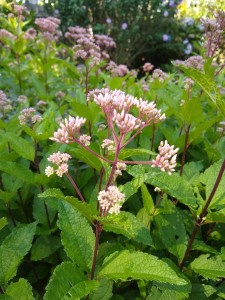What do Thomas Jefferson, early American nurseryman John Bartram, and a long-ago Native American healer have in common with the twenty-first century Dutch plantsman Piet Oudolf?
All are part of the long history of Joe Pye Weed, a beautiful and useful native perennial. Jefferson used the plants in his garden, John Bartram sent seeds to friends in Europe, and Joe Pye, a Native American healer, reputedly used plant parts in medicinal concoctions. He also lent his name to the species most often used in gardens. Fast forward to the present day, and Piet Oudolf uses the plants in his pioneering “new perennial” landscapes, including the gardens of New York’s fabled High Line.
Those who concern themselves with Latin names should know that Joe Pye used to belong to the Eupatorium genus. Now many species have moved over to the genus Eutrochium. The plants themselves had no say in the matter. Responsibility for the confusion that will ensue because of this change may be laid at the feet of the same crew of pesky plant taxonomists that commandeered our simple tall Sedum spectabile—think ‘Autumn Joy’–and transformed it into Hylotelephium spectabile.
That group, though they are no doubt devoted to botanical and scientific accuracy, have a lot to atone for. Most vendors still refer to the genus as Eupatorium, and dirt gardeners, of whom I am one, call them Joe Pye weed.
There are between 30 and 60 species of Eutrochium, depending on which botanists you consult. All of them are native to the Northern Hemisphere, and the ones most common in U.S. gardens are native to North America. They are members of the enormous Asteraceae or daisy family, though you would be hard-pressed to see the resemblance to a common ox-eye or even Shasta daisy.
What you will see when you look at Joe Pye weed, is a tall plant—up to seven feet or more–most often with sturdy stems growing up through whorls of large, serrate or toothed green leaves. The flowerheads, which appear atop those stems, consist of scores of tiny individual flowers clustered into a rounded or domed shape. One of the great charms of many Joe Pyes is the fragrance, which, in some species, has been likened to vanilla. Pollinators, especially butterflies, love it.
At this time of year, you can also see clumps of Joe Pye out in the country, growing in the damp ditches that edge farm fields, or on the edges of wooded areas. The flowers will look like a purple haze from the window of your speeding car.
In my garden, I have lots of Eutrochium purpureum, also known as purple Joe Pye weed or sweet Joe Pye weed, featuring green stems, purple leaf nodes, and purple-pink flowerheads. Other widely available species include varieties of Eutrochium maculatum, which often bears stems that are entirely purple or purple-spotted. ‘Dwarf Red’, with ruddy flowerheads, purple stems and relatively short stature—topping out at 36 inches—is a maculatum. ‘Little Joe’ is a variety of the wonderfully-named Eutrochium dubium or dubious Joe Pye weed. It shares all the desirable characteristics of its Joe Pye relatives, but also boasts small stature, at three to four feet tall. Eutrochium fistulosum, with hollow stems and flowerheads, is the largest of the Joe Pye weeds, growing up to eight feet tall, but without notable fragrance. Whether scented or not, the Joe Pyes are full of the nectar that attracts pollinators.
My garden would be completely unbalanced if I gave my Joe Pye weeds free reign, so I treat the plants to the “Chelsea chop”, cutting them back by one third at least three times between the time they emerge in the spring and their early August bloom time. That method allows them to flower at three to four feet tall, instead of towering over me at seven feet.
All Joe Pyes make excellent cut flowers. The dried flowerheads also work well in everlasting arrangements. This is a good thing, since removing the dried flowerheads is the only way to curb the rampant reseeding tendencies that are part and parcel of the Joe Pye weed experience. Once bloom is over, you can cut the stems nearly to the ground without worry—your Joe Pyes will be back next year, and despite whatever effort you put into controlling them, will have produced plenty of offspring. Grub those offspring out as soon as they emerge in spring unless they happen to come up in places where they are wanted.
While the plants like consistent moisture, most will also adapt to drier conditions once they are established. When in doubt, buy Eutrochium purpureum, which is the most drought tolerant species. Grow your Joe Pyes in full sun or light shade. The plants will stand up well to clay soil and will even grow within reach of the allelopathic or growth-suppressing roots black walnut trees.
Many nurseries carry Joe Pye weed. For a good mail order supplier, try Digging Dog Nursery, 31101 Middle Ridge Road, Albion, CA 95410; (707) 937-1130; www.diggingdog.com. Print catalog available.

